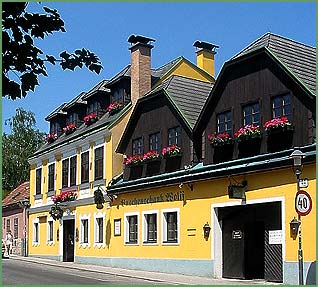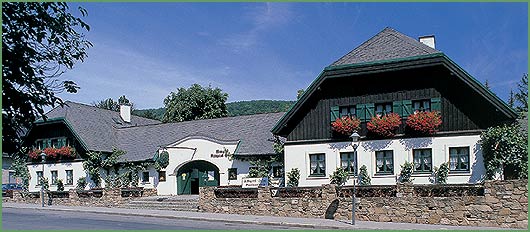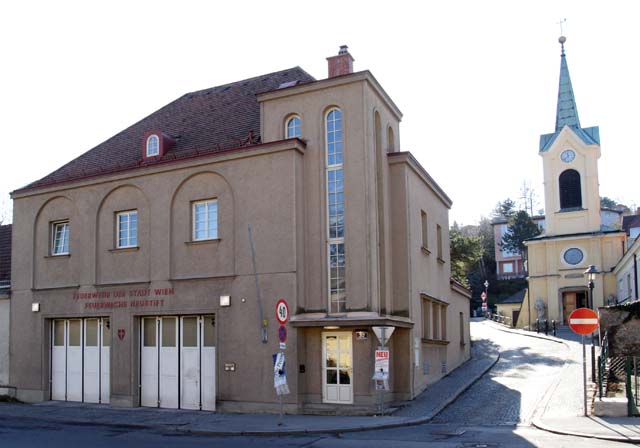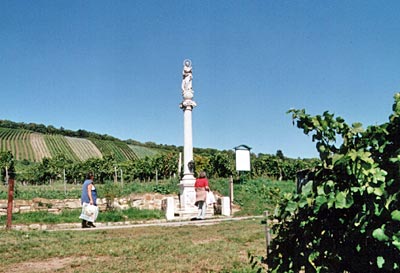Neustift am Walde
Neustift am Walde was a separate municipality until 1892 and is now a part of Vienna in the 19th district of Vienna Dobling and one of the 89 Vienna Katastralgemeinden.
Geography
Neustift covers an area of 209.85 ha, of which is over a third ( 58 ha ), mainly the Dorotheer forest and Neustift cemetery, in the municipality of Waehring while the Döblinger part of Neustift ( 151.85 ha), among others, the includes the old town center.
Neustift is located northwest of Pötzleinsdorf, west of Sievering, east of Neuwaldegg and southeast of Salmannsdorf. The village is laid out in two long rows of houses, which are separated by a narrow road that accompanies the upper Krottenbach. A road connects Neustift am Walde with Salmannsdorf and Crimea.
History
Naming
The name Neustift was first mentioned in 1330 and probably comes from the fact that after the fall of the place Chlainzings west of it was a new foundation on the forest.
Neustift in the Middle Ages
Neustift am Walde was probably founded as a successor to the settlement deserted Chlainzing. Features of this are next to the name the local form and the systematic clearing and settlement. The inhabitants were farmers who produce mainly for their own consumption. For the sale of wine was grown. Neustift was initially owned by different owners. The parish membership changed. The foundation charter of Sieveringer parish church from 1330 shows that the Neustift together with the population of Sievering and Salmannsdorf a church built in Sievering. The parish affiliation changed in the wake of the Holy City to the parish Sievering. 1413 the brothers zinc sold it to the pastor of Gars am Kamp, in turn, the Augustinian Canons of St. Dorothy founded in 1414 and handed the pen his possession. 1435, the place had already 24 houses.
Neustift in modern times
Like the neighboring settlements Neustift was severely affected in the forest during the two Turkish sieges. A particularly poor harvest during the reign of Maria Theresa led to a special custom in Neustift. After the Empress the place it adopted the tax, the winemakers of the Empress brought a wine tavern crown. With the mission on August 16, the anniversary of the church's patron St. Roch, hold a Kirtag the crown came back to Neustift. It is now preserved in the Crown Parlor Eischer family. Not the original of the historic Hauer crown, but a copy used - At the annual Hauer crown move will now - for conservation reasons.
1713 the plague raged in Neustift and in the same year was donated as a commemoration of an Italian merchant, the Rochus chapel. When Joseph II had dissolve the Dorotheastift, Neustift am Walde came to the Abbey of Klosterneuburg. In addition Neustift was elevated to a parish and own the chapel was converted into the parish church of Neustift. Of the damage caused by the French troops at the beginning of the 19th century Neustift recovered only with difficulty. However, from the mid-19th century it came through tourism ( summer ) to an upsurge in place. The houses were equipped with rooms for wealthy Viennese, created some guest houses. However, Neustift am Walde remained a tranquil place. The threat was finally Krottenbach 1908/ 09 transfixed by overbuilding, after the Bach 1907 Neustift had flooded for the last time.
In 1892, Neustift am Walde was incorporated together with Salmannsdorf, Waehring, wine house, Gersthof and Pötzleinsdorf as District Waehring to Vienna. In 1938 they suggested the villages of Neustift am Walde and Salmannsdorf to the 19th district ( Dobling ). However, the Neustift cemetery remained part of the district Waehring.
Today Neustift am Walde is a popular Heurigenort. In the summer, still there is a much visited Kirtag in commemoration of the tax exemption of Maria Theresa.
Economy
The distribution of the walking area in the early 19th century shows the importance of forest and wine clearly. In 1826 the walking area got together to one third of forest and a quarter are from vineyards and meadows. The agriculture accounted for only about ten percent.
Population growth
1435 was the site of 24 houses and grew up in the episode hardly. In 1832 the town had 38 houses with 307 inhabitants, about as much as 40 years earlier. The growth of the surrounding villages made Neustift in the 19th century with only limited. 1850, the city had grown to 50 houses with 575 inhabitants, 1890, the site of 73 houses where 483 people lived.
Traffic
Originally a Stellwagen connection via Neustift to Salmannsdorf whose city -side endpoints changed frequently. The operators changed several times due to financial reasons. This line was subsidized but the only Stellwagen line of the City of Vienna. In 1908, however, even a trolley bus on the system Mercédès - ƒlectrique -Stoll of Pötzleinsdorf about Neustift am Walde was opened after Salmannsdorf of the Vienna municipal trams. As one of the longest lines according to this system, it was only in 1938 replaced by a bus line with the line name 23 but was completely set the following year.
1928 bus line was opened on the Krottenbachstraße to Neustift and Salmannsdorf ( from 1935 line 20). Because of the war effort farms along the route, this line was the last bus lines in Vienna, which was still in operation during World War II. 1942 began with the conversion to trolleybus. From 1946 the town was thus again operated by trolleybuses, as the trolleybus 22 from Währingergürtel after Salmannsdorf went into operation. In 1958 was again the return switch to bus operation. The line designation was 1946 to 1961 22 to 1972 39A and 35A then until today. This now leads from the station spittelau on the Krottenbachstraße and Neustift am Walde to the last stop Salmannsdorf.







